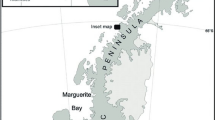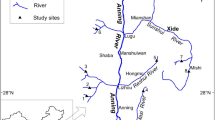Abstract
Little information is available regarding fish diets in Antarctica and how they relate to prey availability. The primary objective of this work was to describe the diet of Trematomus bernacchii. The second objective was to compare prey taken with prey present in the benthos along a spatial gradient of prey abundance using Ivlev's Index of Electivity. All samples were collected from 4 different sites on the east side of McMurdo Sound, Antarctica. Fish were captured by divers at the same depth at each site and their stomachs were flushed for dietary analysis. The diet of T. bernacchii varied among sites, and prey selectivity varied inversely with prey abundance. Many of the prey taken by T. bernacchii were sedentary species suggesting that T. bernacchii is a hunt and peck predator.
Similar content being viewed by others
References
Arnaud P, Hureau J (1966) Regime alimentaire de trois Teleosteens Nototheniidae Antarctiques (Terr Adelie). Bull Inst Oceanogr Monaco 66 (1368):3–24
Barrera-Oro E, Casaux R (1990) Feeding selectivity in Notothenia neglecta. Nybelin, from Potter Cove, South Shetland Islands, Antarctica. Ant Sci 2 (3):207–213
Daniels R (1982) Feeding ecology of some fishes of the Antarctic Peninsula. Fish Bull 80 (3):575–588
Dayton P, Oliver J (1977) Antarctic soft-bottom benthos in oligotrophic and eutrophic environments. Science 197:55–58
Dayton P, Newman W, Oliver J (1982) The vertical zonation of the deep-sea Antarctic acorn barnacle Bathylasma corolliforme (Hoek): Experimental transplants from the shelf into shallow water. J Biogeo 9:95–109
DeWitt H (1971) Coastal and deep-water benthic fishes of the Antarctic. Amer Geoph Soc Antarctic Map Folio Series Folio 15:1–10
Duarte W, Moreno C (1981) The specialized diet of Harpagifer bispinis: Its effect on the diversity of Antarctic intertidal amphipods. Hydrobiologia 80:241–250
Eastman J (1985) Pleuragramma antarcticum (Pisces, Nototheniidae) as food for other fishes in McMurdo Sound, Antarctica. Polar Biol 4:155–160
Eastman J (1991) Evolution and diversification of Antarctic Notothenioid fishes. Am Zool 31:93–109.
Eastman J, Grande L (1989) Evolution of the Antarctic fish fauna with emphasis on the recent Notothenioids. In: Crane JA (ed) Origins and evolution of the Antarctic biota. Geol Soc Spec Publ 47:241–252
Field J, Clarke K, Warwick R (1982) A practical strategy for analyzing multispecies distribution patterns. Mar Ecol Prog Ser 8:37–52
Grande L, Eastman J (1986) a review of Antarctic ichthyofaunas in the light of new fossil discoveries. Palaeontology 29 (1):113–137
Hoekstra D, Janssen J (1985) Non-visual feeding behavior of the mottled sculpin, Cottus Bairdi, in Lake Michigan. Environm Biol Fish 12 (2):111–117
Hureau J-C (1970) Biologie comparee de quelques poissons Antarctiques (Nototheniidae). Bull Inst Oceanogr Monaco 68 (1391):1–244
Janssen J, Coombs S (1990) Comparisons in the use of the lateral line for detecting prey by Notothenioids and Sculpins. Antarctic J US 25 (5):214–215
Lenihan H, Oliver J, Oakden J, Stephenson M (1990) Intense and localized benthic marine pollution around McMurdo Station, Antarctica. Mar Poll Bull 21 (9):422–430
Linkowski T, Presler P, Zukowske S (1983) Food habits of Nototheniid fishes (Nototheniidae) in Admiralty Bay (King George Island, South Shetland Islands). Pol Polar Res 4 (1–4):79–95
McKenna J Jr (1991) Trophic relationships within the Antarctic demersal fish community of South Georgia Island. Fish Bull 89:643–654
Montgomery J, Pankhurst N, Foster B (1989) Limitations on visual food location in the Planktivorous Antarctic fish Pagothenia borchgrevinki. Experientia 45:395–397
Moreno C (1980) Observations on food and reproduction in Trematomus bernacchii (Pisces: Nototheniidae) from the Palmer Archipelago, Antarctica. Copeia 1:171–173
Moreno C, Osorio H (1977) Bathymetric food habit changes in the Antarctic fish, Notothenia gibberifrons Lonnberg. (Pisces: Nototheniidae). Hydrobiologia 55 (2):139–144
Oliver J, Slattery P (1985) Effects of crustacean predators on species composition and population structure of soft-bodied infauna from McMurdo Sound, Antarctica. Ophelia 24 (3):155–175
Permitin Y, Tarverdiyeva M (1972) The food of some Antarctic fish in the South Georgia area. J Ichthyol 12:104–114
Richardson M (1975) The dietary composition of some Antarctic fish. Brit Ant Surv Bull 41 & 42:113–120
Tarverdiyeva M, Pinskaya I (1980) The feeding of fishes of the families Nototheniidae and Chaenichthyidae on the shelves of the Antarctic Peninsula and the South Shetlands. J Ichthy 20:50–60
Author information
Authors and Affiliations
Rights and permissions
About this article
Cite this article
Kiest, K.A. A relationship of diet to prey abundance and the foraging behavior of Trematomus bernacchii . Polar Biol 13, 291–296 (1993). https://doi.org/10.1007/BF00238355
Received:
Accepted:
Issue Date:
DOI: https://doi.org/10.1007/BF00238355




